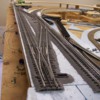I used stone dust from the same rock crushing plant that CSX got theirs from.
About 16 paper grocery sacks (doubled for strength)(heavy stuff required two trips with the Volvo wagon) of it yielded over 100 coffee cans of ballast. Enough for over 500 feet of Gargraves track laid on Homabed.
Step 1 wash it with a garden hose to get rid of excess dirt and dust.
Step 2 pick out any obviously over-sized stones.
Step 3 bake in throw away aluminum pans for about an hour at 250-275 degrees.
Step 4 sift through a homemade screening box to a uniform size.
Step 5 store in coffee cans until ready for use.
Cost? The guard at the plant gate said "help yourself"; i gave him a $5 tip each trip as a way of saying "thanks". He said, "Come back anytime".
jackson
NOTE: You can't say this stuff isn't prototypical!






